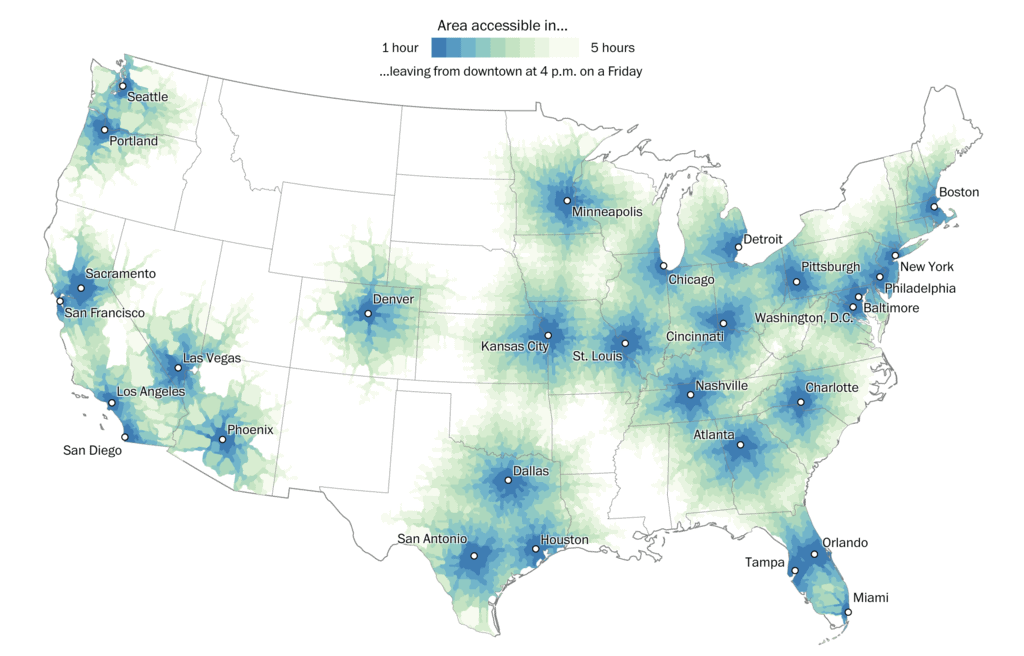
In a way, a city's traffic acts like a fingerprint. Each city has its own unique set of roads, stops, and spoken and unspoken rules. In the end, the emerging traffic patterns become more than an inconvenient frustration —they reflect how our cities are built and how people interact with them. High traffic levels during peak hours can indicate a city's infrastructure inadequacies. The U.S. Environmental Protection Agency highlights the connection between these factors by analyzing the relationship between transportation-related emissions and environmental and public health concerns.
Poor urban planning often sets the stage for traffic congestion, creating a ripple effect that significantly impacts air quality. Cities designed without efficient transportation systems at the forefront usually result in a significant lack of connectivity and inadequate public transportation options. These conditions lead to a heavy reliance on individual vehicles on a limited number of roads. As you can imagine, high volume, limited space, and little to no alternatives lead to severe congestion and endless stop-and-go traffic during peak hours.
This is where the problem gets more serious. When vehicles are stuck in this stop-and-go traffic or are left idling for prolonged periods, their engines emit more pollutants than when driving smoothly and consistently. These pollutants include particulate matter, carbon monoxide, volatile organic compounds, and nitrogen oxides, which are detrimental not only to our health but also to the health of the environment. Additionally, the heat generated by congestion intensifies the chemical reactions in the atmosphere that produce ground-level ozone, a key component of smog. Not to mention that poorly managed traffic not only exacerbates air quality issues but can also indirectly affect water quality through runoff from congested roadways laden with pollutants. The compounded result is a city with deteriorating air quality, which poses risks to public health, accelerates climate change, and diminishes the overall quality of life in cities.
A city's geography significantly impacts the way traffic emissions and other forms of pollution impact its air and water quality. Let's take a look at Salt Lake City, for example. Located in a basin where temperature inversions frequently trap pollutants near the ground, the impact of vehicle emissions on air quality, particularly during winter, is amplified. In order to combat these adverse effects, the city has made several investments, including promoting public transportation and investing in electric vehicle (EV) infrastructure to limit the public reliance on personal vehicles likely to produce high emissions.
Los Angeles remains a focal point for air quality challenges, especially regarding ozone levels. Despite some improvements and attempts to alleviate traffic in the area, the city's infamous reputation for having some of the most dense traffic in the country continues. So far, strategies have included adopting regulatory measures and policies on industrial pollution and updated urban planning.
In Phoenix, the rapid pace of urban sprawl has led to increased vehicle use and a growing urban heat island effect. This combination exacerbates particulate matter (PM) and ozone pollution, particularly during summer. The city is now prioritizing green infrastructure and shaded public spaces in an effort to limit rising temperatures and improve air quality.
Problem Solving with Urban Planning
Tree-lined streets, urban wetlands, and permeable pavements are already a reality in cities worldwide. With new technology and innovation, the cities of the future will not only have improved air quality and managed stormwater runoff, but they will also be efficient ecosystems where people can thrive without damaging the environment.
Green infrastructure can play a transformative role in our communities. As you examine the challenges of traffic, air quality, and urban design, take into consideration the following questions:
Discover more engaging activities and insightful articles designed to spark curiosity and promote sustainability on The Watt Watchers of Texas! Dive into resources that help you explore energy efficiency, conservation, and environmental stewardship in a fun and interactive way. Start your journey here.
We'd love to help answer any questions and help you get started! Drop us a line and we'll get back to you as soon as we can.
Watt Watchers of Texas
204 E. Dean Keeton Street, Austin, Texas 78712
contact@watt-watchers.com
Nos encantaría contestarle cualquier pregunta que tenga y ayudarle empezar! Envíenos un mensaje y nos pondremos en contacto con usted lo antes posible.
Watt Watchers de Texas
204 E. Dean Keeton Street, Austin, Texas 78712
contact@watt-watchers.com